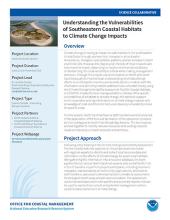
Climate change is having an impact on salt marshes in the southeastern United States through sea level rise, increases in air and water temperature, changes in precipitation patterns, and an increase in storm event intensity. However, the degree and intensity of these impacts vary from marsh to marsh, depending on local environmental conditions. Understanding this local variability is critical when making management decisions. Estuarine reserves in North and South Carolina are seeking to improve local understanding of climate change effects on southeastern marshes, and provide decision makers with the information and skills they need to address these vulnerabilities by using the Climate Change Vulnerability Assessment Tool for Coastal Habitats, or CCVATCH. Created to help managers better understand the specific vulnerabilities of a habitat to climate change, this decision support tool incorporates existing information on climate change impacts with knowledge of local conditions to help users develop vulnerability scores for specific areas.
About this resource
This project overview describes a 2016 Science Transfer project where North Carolina Reserve staff members were fully trained in the application of the tool and facilitation of the assessment process by their colleagues from the North Inlet-Winyah Bay Reserve. The two reserves worked together to identify relevant resources and existing research needs and develop outreach products and activities. The overview highlights the project approach, benefits, products, and next steps.